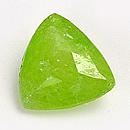|
|
|
|
Click on a letter above to view the list of gems. |
|
|
|
|
|
Pyromorphite |
|
| Chemistry: Pb5(PO4)3Cl [Lead Chlorophosphate] | |
| Discovered
in 1813;
IMA
status: Valid (pre-IMA; Grandfathered). | ||
|
| ||
|
Classification |
|
|
| |
|
Phosphates | |
|
7/B.39-150 | |
|
|
8 : PHOSPHATES, ARSENATES, VANADATES |
|
Related to: |
A member of the Apatite Group, Pyromorphite Subgroup, Mimetite-Pyromorphite Series. It is the phosphate analogue of and is isostructural with Mimetite and Vanadinite. It also forms a series with an unnamed OH-analogue of Pyromorphite. |
|
|
|
|
Crystal Data |
|
|
|
|
|
Crystals short to long prismatic, may be acicular [0001], with prominent [1010], [0001], [1011], [2021], hoppered terminations typical, to 8 cm, rarely tabular to equant; radiating to branching groups, tapering to a point. Commonly rounded, globular, reniform, botryoidal. |
|
|
On [1122], very rare |
|
|
|
|
|
Physical Properties |
|
|
|
|
|
[1011] Imperfect |
|
|
Irregular, Uneven, Subconchoidal |
|
|
Brittle |
|
|
3.5 - 4.0 |
|
|
7.04 (g/cm3) |
|
|
None or may fluoresce yellow to orange under LW and SW UV. |
|
|
Not Radioacitve |
|
|
Other: |
Piezoelectric if Biaxial (may be anomalously Biaxial) |
|
|
|
|
Optical Properties |
|
|
|
|
|
Green, Yellow, Brown, Grayish White, Yellowish Red |
|
|
Transparent to Translucent |
|
|
Adamantine, Resinous |
|
|
2.049 - 2.059 Uniaxial ( - ); may be anomalously Biaxial ( - ), sectored |
|
|
0.0100 (very high) |
|
|
Very Strong; r > v |
|
|
Weak |
|
|
|
|
|
Occurances |
|
|
|
|
|
Geological Setting: |
A secondary mineral in the oxidized zone of lead deposits; rarely a volcanic sublimate. |
|
Common Associations: |
Anglesite, Cerussite, Galena, Plumbogummite, Smithsonite, Silver, Willemite |
|
Type Locality: |
n/a |
|
Year Discovered: |
1813 |
|
View mineral photos: | |
|
|
|
|
More Information |
|
|
|
|
|
| |
|
|
|
|
The
main sources of large, bright green, gemmy crystals
are Guilin Prefecture, Guangxi Zhuang Autonomous Region,
China; Ussel, Corrčze, Limousin, France, Villaviciosa de Córdoba, Sierra
Morena, Córdoba, Andalusia, Spain; and Coeur d'Alene District, Shoshone County, Idaho, USA. |
|
|
We
have not photographed the Pyromorphite gems. Please
check back soon. |
